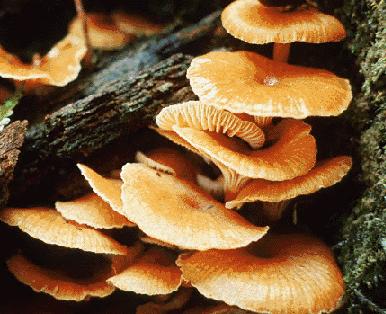Powerpoint: Fungi General Characteristics
Learning Objectives
- Identify the characteristics of Kingdom fungi
- Explain the role fungi play in the ecosystem
- Identify the common characteristics of Kingdom fungi
Take a piece of paper and draw the first thing that comes to mind when you think “fungi”.
It may look something like this:
%20square.jpg)


If you drew something like this, than you’re thinking like google (these are 3 of the first pictures when doing a google search of “fungi”). Most of us consider fungi to be synonymous with “mushroom”, of the club shaped fruiting bodies above. However, mushrooms make up only a small part of the kingdom. Almost all the things we consider “mushrooms” belong to one of five fungi phyla (phyla Basidomycota). Not only that, the visible mushrooms here are only the tip of the iceberg. Where a mushroom sprouts, you could be standing on meters, sometimes even miles, of fungi hidden underground. The largest living organism in the world is thought to be the honey fungus in blue mountain, Oregon, hiding 2.4 miles of monstrosity underground (article below). This is one of the reasons fungi are called the “hidden kingdom”: hidden from view, under-appreciated, but ever present and important in our livelihoods and the ecosystem.
http://www.bbc.com/earth/story/20141114-the-biggest-organism-in-the-world
- Fungi are one of three kingdoms (plus animalia and plantae) that are multicellular.
- Like Plants and animals, fungi are also eukaryotic, meaning it has a nucleus and other organelles, all membrane bound.
- Fungi have cell walls, usually made up of chitin (but not always)
- Like animals, but unlike plants, fungi are heterotrophic. That is, they depend on other organisms (organic material) for their energy. Therefore, contrary to popular belief, fungi are believed to be more closely related to animals than either kingdom are to plants.
- Fungi do not ingest their food like animals do
- Instead, they secrete digestive enzymes outside their cell walls and membrane.
- The digestive enzymes break down the food into small pieces, which can then be absorbed through the cell walls and membrane
- Essentially the whole fungi acts as a stomach and intestines, secreting enzymes and then absorbing them
- In the ecosystem, fungi act as major decomposers
- Other than yeast (unicellular), all fungi are made up of tiny filaments called hypae. The hyphae are usually tangled into a thick mass, called mycelium.
- Most fungi can reproduce sexually and asexually
